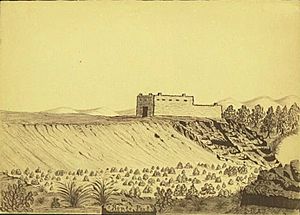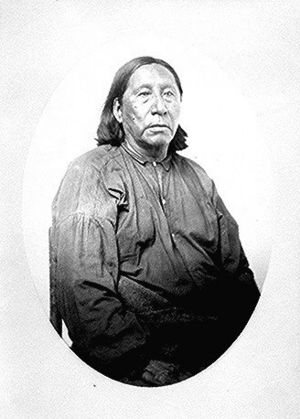Bent's New Fort facts for kids
Bent's New Fort was an important fort and trading post located on the Arkansas River in what is now Bent County, Colorado. It was built along the Mountain Route branch of the famous Santa Fe Trail, about nine miles west of Lamar, Colorado. A fur trader named William Bent built and ran this post. Later, in 1860, he leased the fort to the United States government, which used it as a military fort until 1867. In 1862, its name was changed to Fort Lyon. The fort was eventually abandoned after a big flood of the Arkansas River in 1867.
Today, the ruins of Bent's New Fort and a part of the Santa Fe Trail are recognized as a historic site. They were added to the National Register of Historic Places in 2016.
Contents
Building a New Trading Post

In 1849, William Bent first built a simple wooden fort and trading post. It was shaped like a "U" with three connected log cabins, and the open side faced the Arkansas River.
He then built a much stronger fort and trading post using limestone or sandstone. This construction happened in the summer and fall of 1853. The new fort was built close to a Native American camping area called Big Timbers, which was used by the Cheyenne and Arapaho people. This new fort was a bit smaller than Bent's first fort, called Bent's Old Fort, which Bent had destroyed in 1849. He destroyed the old fort to prevent others from using it against his wishes.
The new stone fort had walls that were 16 feet tall. It featured twelve rooms built around a central courtyard. For protection, cannons were placed in the corners of the roof, and there were special walls called parapets for defense.
Where Was the Fort Located?
The new fort was built on a hill that overlooked the Arkansas River. From this spot, people could see for miles along the Santa Fe Trail. It was in a very good defensive spot, with a limestone cliff to the east and a rock bluff to the south.
About ten men worked at the fort. They came from different backgrounds, including Native American, French-Canadian, Mexican, and white American. Many of them had been trappers, and most had at least one Native American wife.
Life and Changes at the Fort
William Bent was able to start trading again with Native Americans once enough goods arrived. However, trading was not as successful as it had been in the 1830s and 1840s at the Old Fort. Many travelers moving west had reduced the amount of wildlife, especially buffalo. For example, cutting down cottonwood trees harmed the natural homes of animals, making it harder to find game for hunting. The fur trade had also become much smaller.
All these changes meant that Native Americans faced hunger, and there were fewer buffalo hides to trade for goods. For instance, by 1857, the Arapaho people, led by Little Raven, who camped near the fort, struggled to find enough food. Children sometimes showed signs of severe hunger. This hunger, along with plans for a railroad to cross Cheyenne and Arapaho hunting grounds and more settlers arriving, caused worry among Native American groups.
The Fort Becomes a Military Post
Because the new trading post wasn't making much money, Bent briefly leased it to the United States Army in July 1857. He then ran it as a trading post again. By 1860, an area near the fort was used to give out supplies to the Cheyenne and Arapaho, who were very hungry and needed food as they prepared for a buffalo hunt. Bent did not want the fort itself to be used for storing these supplies, as it could lead to problems. These supplies were given as part of treaties, where Native Americans agreed to less access to their traditional lands, like hunting grounds.
In July 1860, the Army rented the fort again and used it to store supplies for the Cheyenne and Arapaho. The Army built barracks around the fort and added more defenses, like special gun placements on new earthen walls that surrounded the fort. The fort was first called Fort Flaunteroy, then Fort Wise, and finally Fort Lyon. The Army stayed at the fort until 1867, when they moved to a new Fort Lyon after the Arkansas River flooded. The original fort site was not used after the Army left.
When Bent leased the fort to the Army, he moved to the south side of the Arkansas River, near Boggsville. There, he built a new stockade called Purgatory Stockade. He lived there until he passed away in 1869. Today, only the foundation ruins of Bent's New Fort remain. The fort is located on private land.



